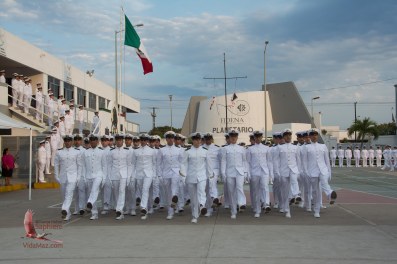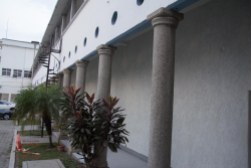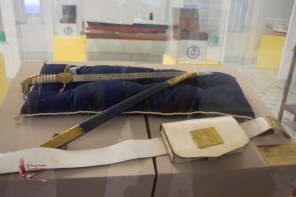 Mazatlán has been renowned since colonial times as one of Mexico’s premier maritime and shipbuilding centers. It is thus quite natural that we are blessed with the country’s oldest merchant marine academy—La Escuela Nautica Capitán de Altura Antonio Gómez Maqueo, or “La Nautica,” as it is affectionately known. The school also distinguishes Mazatlán as home of the oldest merchant marine academy in Latin America.
Mazatlán has been renowned since colonial times as one of Mexico’s premier maritime and shipbuilding centers. It is thus quite natural that we are blessed with the country’s oldest merchant marine academy—La Escuela Nautica Capitán de Altura Antonio Gómez Maqueo, or “La Nautica,” as it is affectionately known. The school also distinguishes Mazatlán as home of the oldest merchant marine academy in Latin America.
Visiting family and I were fortunate to get up close and personal with the highly disciplined young adults parading in their dress whites during the school’s recent 137th anniversary ceremony. Watching hundreds of young people march in crisply choreographed unison during the golden hour at sunset was truly a sight to behold! We were invited to the bugle, drum and flag-filled festivities by Captain Rodolfo Cinco Arenas, who has taught at the academy longer than anyone on the staff—since 1982. Though Captain Cinco was able to retire a few years ago, the school persuaded him to come back as a contract teacher because he is a leading expert on ship stability and GMDSS, the global maritime distress and safety system. Walking around campus with the Captain was so much fun, as all the gorgeous young cadets saluted us as we walked by.
The Nautica is a public school operated under the auspices of the Secretary of Communication and Transportation’s FIDENA (Fideicomiso de formación y capacitación para el personal de la marina mercante nacional). It currently educates 653 students from throughout Mexico and Latin America as officers and engineers for all types of commercial vessels: container ships, ferries, fishing vessels, freighters and tankers. Cadets are nearly evenly divided between deck (mates and captain) and engineering. The school opened to women in 1994 and currently includes more than 50 female cadets. Since its inception it has trained 2500 officers who are able to sail vessels from almost any country around the world, frequently including Algeria, Brazil, Dubai, and Venezuela, though Canadian and US American vessels limit officers to citizens from those respective nations. Tuition is $67,000 pesos/year and includes everything: housing, food, books, classes and simulators. The experience is of course highly subsidized by the federal government.
Despite presidential decrees founding a merchant marine academy in Mazatlán in 1857 (Ignacio Comonfort) and 1880 (Porfirio Diaz), fates dictated that the Nautica’s first classes weren’t held until December 1888, when the Chilean vessel Buque México arrived in Mazatlán from San Francisco. The ship served as home to the school’s first class of 15 students. In 1921 the Nautica moved to 43 Calle del Arsenal, which today is where Venustiano Carranza meets the malecón; a plaque indicates this fact. In September of 1939 classrooms, workshops, dormitories, sports fields, a cafeteria and a small dock were constructed at the school’s current site at 2111 Calzada Gabriel Leyva. During World War II the school was temporarily transferred to the navy (1941-58), and for a few years graduates could opt for a degree as either military or merchant marine officers.
The curved façade of the main building of the Nautica is reminiscent of the bridge of a ship. Classrooms and dormitories form a large central square, where the ceremony was held. Spiral staircases, stone columns, carved wood, antique tile floors, student-painted murals and lush palm trees make for an impressive campus. From 1982 to 2006 the academy had an educational ship named “Nauticas México;” cadets navigated the vessel throughout the Americas and Europe. It was the only merchant marine training vessel in Mexico, but has never been replaced, as the government has decided simulators are cheaper and better for educational purposes. The Nautica today has 45 professors, 25 classrooms, 12 simulators, beautiful lap and diving pools, and Mazatlán’s only planetarium (built in 1986), which sadly is not open to the public.
Nautica cadets are civilians, not military, though education is military style. They reside on campus six days a week, and have strict regulations regarding uniforms (dress whites and blues, international and khaki in short and long sleeves), hair length, lights out, language and behavior both at school and during time off. Privileges include Saturday nights and Sunday mornings off campus, and visits by family and friends on Thursday evenings. Those privileges are easily and frequently lost, however, as we well know from our son’s friends’ experiences.
Entry to the academy is extremely competitive, open to high school graduates and those who pass very challenging entrance exams. Even when accepted, quite a few cadets drop out prior to graduation due to the rigor of the curriculum and lifestyle. Cadets live and study on campus July through December and January to June, with one month break in the summer. Graduates must pass their classes and professional exams, be able to swim, and have English proficiency to complete the four-year program. Once they graduate, they still need to come up with $50k pesos to pay for their professional title (título), something common across most careers in Mexico. Graduating from it, however, pretty much guarantees a lucrative career.























































Very interesting. How many years of study is required or does that differ by specialty?
It’s a four-year program for both deck and engineers, Tom. Years ago it was five.
Dear Dianne, good remembrance of my “Alma Mater”, and Im quite sure there are a lot of us around the world feeling proud to came from there, working with discipline and good seamanship skills. We are very thankful for your publication and my regards and recognition to Capt Cinco Arenas, Capt Pablo Osuna, Ing Heberto Pardo, Capt Rafael Vazquez Romellon and all the teachers which gave us formation, discipline and transmit their experiences.
Jesus Ortiz
I will indeed give them your regards, Jesus. So glad the article let you reminisce and feel pride in the Nautica. We are so privileged to have it here. Where are you now?
I HEAR A RUMOR OF THEY GONNA SHUT DOWN THE SCHOOL FOR COUPLE YEARS??
No one at the school confirmed that to me, Iván. Too many rumors here. Let us hope not.
My husban graduated from one of these Nautica schools. Till this day he dreams he does not pass exams or is been kicked out. It was very strict with weekend punishments (not letting them go out or home if they did wrong). But so far he is a very highly trained mechanical engineer graduated from the nautica in Tampico.
Congratulations to your husband, and thanks for sharing, Jane.
Mi primo, Cap. de Alt. Felipe Hernandez Ascencio, es miembro de la 1ra. Generación 1958-1963 reapertura de Escuela Náutica de Mazatlan.
Que orgullo, Carlos, y que bendición tener un primo tan digno! Mis felicidades y gracias por habernos compartido la info!
Mi padre trabajo en la Escuela Náutica de Mazatlán 40 años, desde la re reapertura eno el año de 1958. El director administrativo. Su nombre: Tte. de Navío (Retirado). Carlos Manuel Hernandez Sandez, mejor conocido como Teniente Sandez.
Pingback: Blogs About Mexico Worth Reading–VidaMaz | Surviving Mexico
Hello, how can I join this school
You will need to contact the school directly, Anita. You can follow the link in the article; their Facebook page is https://www.facebook.com/escuelanauticamzt
Pingback: Noche de Luz | ¡VidaMaz!